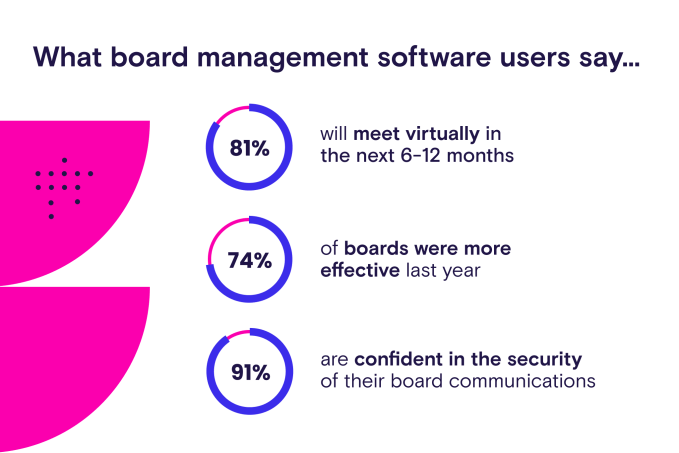Agile, intuitive, and data-rich boardroom technology has yet to reach most board meetings. It’s time for a change.
By Paroon Chadha, co-founder & CEO of OnBoard
If you serve on a board, you know that nearly every board meeting has now operated in a primarily digital setting for two full years. For many boards, this digital and virtual shift unlocked an entirely new world of increased effectiveness, collaboration, and agility.
In fact, according to a recent survey conducted on behalf of my company, OnBoard, 74% of board directors and executives said they increased their board’s effectiveness in the last 12 months using board management software. This is especially compelling when 81% of respondents indicate they’ll continue meeting using digital platforms for at least the next 6 to 12 months.
We also know that board meetings, on average, have become much shorter due to new digital formats: Analysis of anonymized activity events in our platform indicates that before 2020, the average board meeting lasted about 3.5 hours. Today, in 2022, a board meeting now averages about 2.5 hours. Boards have increased their collaborative efforts to get more done in less time.
Now that even the most experienced board member has embraced the benefits of digital board meetings (willingly or not), it’s time to step up and give board leaders the added advantage of smart, intuitive technology that creates actionable data-based insights for better engagement and more agile board leadership.

Image Credits: OnBoard (opens in a new window)
How can digital transformation create better board effectiveness?
As boards and the organizations they serve continue to adapt to and overcome new challenges, board leaders face a new choice: What’s the best tool for the job?
The promise of board technology is that it reduces administrative processes, reduces cognitive overhead, and bolsters security and compliance thus making board meetings simpler, more informed, and more effective.
Eliminating the administrative hassle of a board meeting
It’s not uncommon for tech executive teams—including my own—to spend weeks prepping for the quarterly board meeting. Not only collating all the data, documentation, and strategy tied to current operations, but also curating historic data and documentation.
A board management platform speeds up this process by creating a centralized repository for all board materials past and present. This “one-stop-shop” for your executive team, directors, and observers makes it easy to quickly locate, share, and collaborate on board materials. It also makes onboarding new directors and investors much faster by providing easy access to meeting materials and other important assets such as bylaws, meeting minutes, policy statements, and other foundational assets.
Enhancing security
Your IP matters, right? And you wouldn’t dream of anything less than a proactive posture to protect your company’s data and your customer’s privacy. Then why wouldn’t you adopt the best security for your board materials, communications, and meeting activities? A board portal with leading security and data protection protocols — such as strong built-in encryption and accreditation as a SOC 2 Type II provider — reduces the number of endpoints available to attack.
Additionally, if the board portal or platform offers user permissions and granular access controls, it will make partitioning sensitive information such as executive compensation deliberation or company valuation data less cumbersome.
Accessibility and mobility without compromise
Work doesn’t stop when you step away from your desk. Today, board directors get board work done at the kitchen table, at the airport, in the Uber on the way to the meeting, and everywhere in between. Board technology that creates a unified mobile experience with seamless cross-device hand-offs is table stakes for today’s modern board.
What’s measured can be optimized: using intelligent data to enhance the board meeting experience
The next step in advancing toward a fully digital posture for governance is deploying board intelligence and using digital feedback to create better meetings.
With OnBoard, for example, board members can view anonymized analytics about which sections of the board book receive the most attention or frequent annotations—making it possible to adjust agendas and topics in real-time to accommodate the right amount of time for discussion (a great improvement over the erstwhile pre-meeting dinner audibles.)
And board-level data can be applied to the most perennially vexing board challenges, such as improving diversity. Capturing each director’s unique attributes, characteristics, and skills in something like OnBoard’s in-platform skills tracking feature can help identify gaps in board composition to inform planning and recruitment.
Adding diversity to the board meeting—whether that contribution comes from personal, cultural, or professional experience—can make your organization more nimble, more adept, and better able to embrace change.
More value across the board: why every tech company needs a purpose-built board platform
No matter what stage your business is in, the benefits of a secure, cloud-based board portal can’t be understated. For early-stage startups focused on perfecting product-market fit and identifying sustainable avenues to growth, executing a board meeting with a scalable and flexible board platform reduces prep time and makes director collaboration easier, giving you more time to focus on your No. 1 priority: Growing the business.
And as you grow, you’re likely to take on new investment capital and therefore more board members. Not only can a board portal help your business sail through due diligence with accurate documentation of board meetings minutes and materials, it also makes onboarding new directors post recapitalization easier and faster.
For larger companies planning an M&A or IPO, a secure board portal is essential. You don’t have to go too far back in the news to see horror stories of leaked board-level strategy, an unfortunate recent example being the late Collin Powell’s 2016 leak of Salesforce acquisition targets due to an email breach.
WeWork’s disastrous attempted IPO was made even potentially more painful due to the fact that some board directors used separate business email addresses to conduct board business, opening up their full inboxes to e-discovery as part of subsequent litigation.
A board portal or platform with robust in-built messaging and data protection could have prevented either issue. More than 90% of all board portal users in OnBoard’s recent survey said they felt confident in the security of their board communications.
These examples also underscore that boards and their directors need to share more, more often, and more expeditiously in this age of market vacillations. Disruptions that shake entire societies and economies—war, pandemic, social justice movements, environmental disasters—now occur more frequently than ever and boards owe it to the organizations they serve to be able to collaborate and engage to meet these challenges with agility.

Image Credits: OnBoard (opens in a new window)
The future is here. We live in an era defined by increasingly prolific innovation: Synthetic genomes, self-piloted vehicles, and flying helicopters on Mars. The board meeting no longer needs to be tethered to the conventions of the past. Boards that embrace the best of what technology has to offer in terms of data intelligence, collaborative communication, and bulletproof security will gain a significant advantage over their peers.